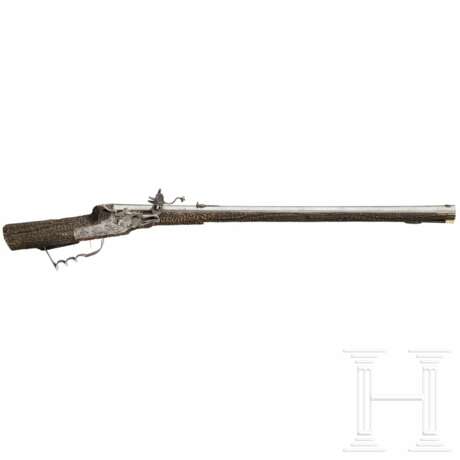ID 833627
Lot 1037 | Außergewöhnliche Radschlossbüchse, Augsburg, um 1660
Estimate value
€ 36 000
Provenienz: Die vorliegende Waffe stammt mit großer Sicherheit aus der Gewehrkammer der Großherzöge von Sachsen-Weimar auf Schloss Ettersburg. Allein das Vorhandensein der Buchstaben "EB" im Kolbenfach ist charakteristisch für diese Provenienz.
Verschiedentlich wurden Waffen aus der Gewehrkammer von Schloss Ettersburg bereits im späten 19. Jhdt. angeboten und die Verkäufe dauerten bis in die Zeit nach dem Ersten Weltkrieg an. In der Auktion des Hauses Fischer/Kahlert aus dem Jahr 1927 (Los 73) fand sich bereits ein Radschlossgewehr, welches, wie das hier vorgestellte, komplett mit Hirschhorn belegt war und das ein Emaille-Medaillon im Kolben trug. Vermutlich ist dies mit dem heute in der Sammlung des Metropolitan Museum of Art in New York befindlichen Exemplar (Accession Number: 2015.446a–d) identisch, das von Martin Kammerer in Augsburg signiert ist. Radschlosswaffen, welche komplett mit rauem, weitgehend naturbelassenem Hirschhorn belegt waren, kamen in den Jahrzehnten zwischen der Mitte des 17. Jhdts. und dem frühen 18. Jhdt. in Deutschland in Mode. Die wenigen erhaltenen Exemplare legen die Vermutung nahe, dass das Produktionszentrum für solche Waffen in Augsburg lag. Eine vergleichbare Waffe befindet sich heute im Bayerischen Nationalmuseum in München (Inv.-Nr. W994). Vgl. auch Auktion Hermann Historica in Brüssel, 13.12.2011, Los 147.
Octagonal barrel in 12.5 mm calibre, slightly swamped at the muzzle. The bore somewhat rough with good rifling, dovetailed brass front sight and one-flap chiselled rear leaf sight on the top. The wheellock with internal wheel, the lock plate with a scene from a wild boar hunt, the cock engraved with mythical sea monsters, set trigger. The wooden full stock and the patch box veneered in staghorn plaques, stamped "EB" on the inside. An enamelled copper plaque with a depiction of Diana reposing with her hunting hounds in a gilt brass frame on the cheek appliqué on the left side of the butt. The stock with a smooth, iron trigger guard. The ramrod thimbles and butt plate also made of staghorn. Length 105.5 cm.
Provenance: It is highly likely that this weapon was originally from the armoury of the Grand Dukes of Saxe-Weimar in Ettersburg Castle. The presence of the initials "EB" in the patch box alone indicates this provenance. Weapons from the armoury of Ettersburg Castle were offered for purchase on various occasions in the late 19th century, with sales continuing until after World War I. The 1927 auction held by Fischer/Kahlert included a wheellock rifle (lot 73), which was entirely veneered in staghorn, like the one presented here, and featured an enamel medallion on the butt. This gun is probably identical with the rifle which is today in the collection of the Metropolitan Museum of Art in New York (Accession Number: 2015.446a–d), signed by Martin Kammerer, active in Augsburg. Wheellock weapons that were completely covered in rough staghorn with a largely natural finish were very much in vogue in Germany in the decades between the middle of the 17th century and the early 18th century. The few examples still surviving today would suggest that Augsburg was the production centre of these weapons. A similar rifle currently forms part of the collection in the Bayerisches Nationalmuseum in Munich (Inv. no. W994). Cf. also the Hermann Historica Auction in Brussels, 13 December 2011, lot 147.
| Auction house category: | Long guns: matchlock and wheellock |
|---|
| Auction house category: | Long guns: matchlock and wheellock |
|---|
| Address of auction |
Hermann Historica Bretonischer Ring 3 85630 Grasbrunn / München Germany | ||||||||||||||
|---|---|---|---|---|---|---|---|---|---|---|---|---|---|---|---|
| Preview |
| ||||||||||||||
| Phone | +49 (0)89 5472 649 0 | ||||||||||||||
| Fax | +49 (0)89 5472 64999 | ||||||||||||||
| Buyer Premium | 25 % | ||||||||||||||
| Conditions of purchase | Conditions of purchase | ||||||||||||||
| Business hours | Business hours
|



